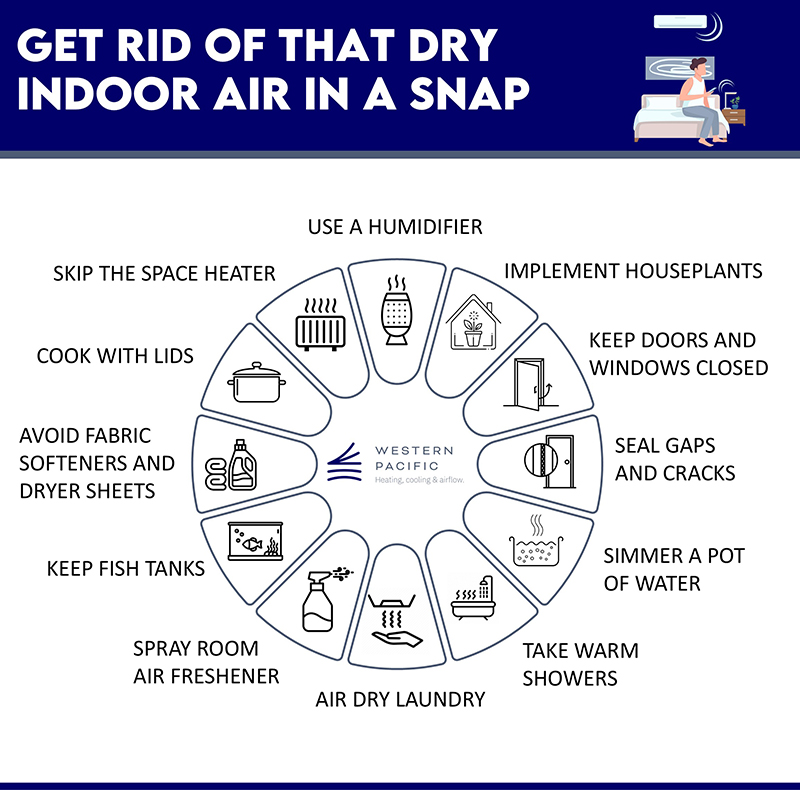We all want our homes to be as comfortable and safe as possible, but sometimes indoor air can become dry and uncomfortable. This is especially true in the winter months when humidity levels drop. Fortunately, there are a few things you can do to help eliminate dry indoor air and improve the comfort of your home. Here are some tips to help you keep your home feeling comfortable and safe.
Use a Humidifier
If you live in an area with low humidity levels, a humidifier can help to add moisture back into the air. This will help to alleviate dryness and reduce the risk of allergic reactions caused by dry air. You can find a variety of humidifiers at your local home improvement store or online. Be sure to follow the manufacturer’s instructions on use and cleaning to ensure optimal performance.
To ensure the humidifier is working properly, use a hygrometer to measure the humidity in your home. This will help you determine whether or not your humidifier is providing the optimal moisture level for your needs. Generally, relative humidity levels inside a home should stay between 30 and 50 percent.
Implement Houseplants
Indoor plants help clean the air and increase humidity levels. This reduces the dryness in your home. Choose plants that require minimal maintenance and are good at purifying the air. Place these plants strategically in your home and ensure they receive enough sunlight and water.
Some common plants that can help reduce dry air in your home include the peace lily, aloe vera, and English ivy. Plants you should avoid, include cactus and succulents, as they may have the opposite effect.
Keep Doors and Windows Closed
Opening the windows and doors to let fresh air in can be tempting when the weather outside is cold and dry. Unfortunately, this will only make your home drier. Keep windows and doors closed, and consider using a door snake to help prevent drafts. In cases where you need to let in the fresh air, consider using exhaust fans to help pull in outside air while reducing the risk of drafts.
You can also invest in an air purifying system, such as an air filtration unit. The design of these units reduces allergens and other pollutants that can cause breathing issues or other health risks.
Seal Gaps and Cracks
Since you’ll be sealing up your home against the cold, dry air, keep a couple of windows cracked during the day. This will allow the moist air to circulate and keep humidity levels up. It may sound counterintuitive, but closing your home too tightly can make the air inside even drier. So don’t be afraid to open a window and let some nice, moist air in.
Simmer a Pot of Water
This may sound like an old-fashioned remedy, but it does work. Put a pot of water on the stove and let it simmer for a few hours. This will add moisture to the air and help reduce dryness. Be sure to keep an eye on the pot; never leave it unattended. When you’re done, turn off the stove and let the pot cool before pouring the water out. Don’t pour hot water down the drain, as it could damage your pipes.

You can also place water bowls near vents or other air circulation sources. Their heat will help evaporate the water, adding moisture to the air. It will also help to reduce static electricity.
Take Warm Showers
Taking a warm shower can help to reduce dry air in your home. However, it’s important to keep showers as short as possible to prevent too much moisture from entering the air. This will help to reduce humidity levels and make your home more comfortable.
For a bonus, hang a towel over your bathroom door while showering. This will help trap the humidity and keep it in the room. When you’re done showering, open the door to let out any excess moisture.
Air Dry Laundry
Rather than using a dryer to dry your laundry, try air-drying it outside when the weather permits. Not only will this help to reduce humidity levels in your home, but it is also better for the environment.
This may not be an option during the winter, but you can hang your laundry out to dry on a clothesline or drying rack in the summertime.
Spray Room Air Freshener
Room air fresheners can help to reduce dryness in your home by adding moisture back into the air. Look for air fresheners designed explicitly for this purpose. You can find them at your local home improvement store or online.
Spraying down your curtain or furniture with an air freshener can also help keep the air moisturized. Just be careful not to overdo it, as this can dampen the air.
Keep Fish Tanks
Fish produce a lot of moisture, making them great for fighting dry air in your home. Just make sure to buy the right type of fish and follow all instructions carefully. Covering your tank with a lid will also help to keep the moisture in. This will increase humidity levels and help make your home more comfortable.
Avoid Fabric Softeners and Dryer Sheets
Fabric softeners and dryer sheets contain ingredients like natural oils that can leave a residue on your clothes. This residue can make your clothes feel softer, but it can also suck the moisture out of the air. To avoid this problem, use alternative methods to soften your clothes – such as wool dryer balls – and avoid using fabric softeners or dryer sheets.
You should also avoid using scented candles or air fresheners with too strong of fragrances, as these can also suck the moisture out of the air.
Cook With Lids
Cooking can also help to reduce dry air in your home. When you cook, make sure to use lids on your pans. This will help to keep the moisture in and reduce dryness. You should also try cooking meals that require lots of boiling or steaming, as this will help add moisture back into the air.
Finally, turn off your stove and oven when you’re done cooking. Leaving them on can suck the moisture out of the air and make your home drier.
Skip the Space Heater
Space heaters may seem like a good way to keep your home warm, but they can also suck the moisture out of the air. Instead, try using a ceramic heater, which will help to add moisture back into the air.
Just make sure to keep an eye on the humidity levels in your home. If they get too high, turn off the heater and open a window or two to let some humid air out.
By following these simple tips, you can eliminate dry indoor air and enjoy a more comfortable home. With a few small changes, you can keep your home at the perfect humidity level, and ensure everyone stays comfortable all year round. To help with your indoor air quality needs, you should contact a professional like Western Pacific Heating, Cooling & Airflow. We can help you with furnace installation and repair, heat pump installation and repair, air purification, water heater installation, cooling services, and commercial HVAC in Vancouver, BC. Reach out to Western Pacific Heating, Cooling & Airflow today to learn more about how we can help.
Call Western Pacific Heating, Cooling & Airflow today!

